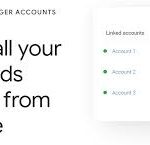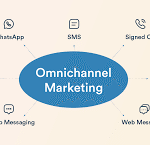In today’s competitive online market, selling on a single platform is not enough. Customers interact with brands through multiple channels – websites, apps, emails, social media, and even physical stores. That’s why omnichannel marketing has become essential for e-commerce brands to provide a seamless customer experience.
This blog is your complete guide to running a successful omnichannel e-commerce marketing campaign to boost sales, build brand loyalty, and stay ahead of competitors.
What is Omnichannel Marketing?
Omnichannel marketing is a strategy where you integrate all your marketing channels and customer touchpoints to provide a consistent brand experience, no matter where customers interact with you.
For example:
- A customer sees your Instagram ad
- Visits your website to check the product
- Receives a personalised follow-up email with a discount
- Purchases through your app and picks up from your physical store
All these interactions are connected, creating a smooth customer journey.
Why is Omnichannel Marketing Important for E-commerce?
✅ Better customer experience leading to higher satisfaction
✅ Increased brand awareness and loyalty
✅ Higher sales conversions by targeting customers on multiple channels
✅ Data-driven insights from integrated platforms to refine future campaigns
Step-by-Step Guide to Running an Omnichannel E-commerce Campaign
Step 1. Understand Your Customers
Start by analysing:
- Which platforms your customers use (Instagram, Facebook, WhatsApp, website, app)
- Their shopping behaviour and preferences
- Common pain points in their buying journey
Use tools like Google Analytics, Facebook Insights, or CRM data to build detailed customer personas.
Step 2. Define Your Campaign Goals
Be clear about what you want to achieve. For example:
✔️ Increase website traffic by 30% in a month
✔️ Boost sales for a new product launch
✔️ Build email subscribers for future campaigns
✔️ Increase app downloads and usage
Clear goals help in crafting targeted messages for each channel.
Step 3. Choose the Right Channels
An omnichannel campaign doesn’t mean using every channel. Focus on where your audience spends time. Popular channels for e-commerce include:
- Website and app push notifications
- Email marketing
- Social media platforms (Instagram, Facebook, Pinterest)
- SMS marketing
- Physical stores (if any)
Step 4. Create a Consistent Brand Message
Your messaging, visuals, and offers should remain consistent across channels. For example, if you’re running a Diwali sale, ensure:
- Website banners highlight the sale
- Instagram and Facebook posts promote it with similar creatives
- Email newsletters announce it with matching visuals
- SMS reminders are short but aligned with the same offer
This builds trust and brand recall among customers.
Step 5. Personalise Your Campaigns
Omnichannel marketing is powerful when personalisation is applied. Use customer data to:
✅ Send product recommendations based on browsing history
✅ Offer birthday or anniversary discounts
✅ Follow up abandoned cart users with emails or push notifications
✅ Show location-based offers (e.g., in-store pickup discounts)
Step 6. Integrate Your Marketing Platforms
Use an omnichannel marketing platform or CRM that integrates all channels for seamless management. Tools like:
- HubSpot
- Salesforce Marketing Cloud
- Klaviyo (for e-commerce stores like Shopify)
- Zoho CRM
These help you track customer interactions, automate campaigns, and analyse performance in one place.
Step 7. Run Targeted Ads Across Platforms
Run retargeting ads to reach users who:
- Visited your website but didn’t purchase
- Added to cart but left without buying
- Purchased before and may buy again
Facebook Ads Manager and Google Ads allow creating retargeting campaigns with custom audiences for better ROI.
Step 8. Optimise Your Website and App for Conversions
Ensure your website and app:
✅ Load quickly
✅ Have a mobile-friendly interface
✅ Display clear call-to-actions
✅ Provide secure and multiple payment options
Because even with the best marketing campaigns, a poor website or app experience will reduce conversions.
Step 9. Track, Analyse, and Optimise
Monitor campaign performance regularly:
- Which channels are giving the best results?
- Which messages had the highest engagement?
- Where are users dropping off in the buying journey?
Use these insights to tweak your campaign for better results and apply the learnings to future campaigns.
Step 10. Focus on Customer Support Across Channels
Lastly, ensure customers can reach you easily for support, whether on:
- WhatsApp Business
- Instagram DMs
- Email support
- Website chatbots
Quick and helpful responses build loyalty and encourage repeat purchases.
Examples of Successful Omnichannel Campaigns
✔️ Nike: Allows customers to check online inventory for physical stores, reserve items, and pick up or return them seamlessly.
✔️ Starbucks: Integrates their app with rewards, ordering, and in-store pickup for a smooth experience.
✔️ Amazon: Uses personalised emails, app notifications, and website suggestions based on user behaviour to drive repeat sales.
Final Thoughts
Running an omnichannel e-commerce marketing campaign may seem complex, but with clear goals, customer understanding, and integrated tools, it can transform your business growth.
Remember:
🔑 Consistency, personalisation, and customer-first approach are the pillars of a successful omnichannel strategy.
At TheBlogSite, we bring you actionable guides to grow your online business efficiently. Stay tuned for more tips on digital marketing, SEO, and social media strategies to keep your brand ahead.








Leave a Reply